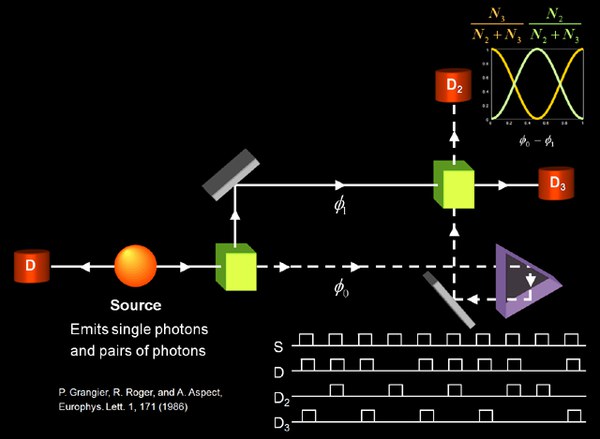Event-by-event simulation of (quantum) optics experiments

The particle behavior of photons has been shown in an experiment (Grangier et al., 1986) composed of a single 50/50 beam splitter, of which only one input port is used, and a source emitting single photons and pairs of photons. We refer to this experiment as experiment I. Using an idealized pictorial description of this experiment one could say that every time one photon of a pair is detected at a detector placed on one side of the source, only one of the two detectors placed behind the beam splitter on the other side of the source gives a click. Hence, since in this idealized picture the two detectors behind the beam splitter never give a click simultaneously, wave behavior is excluded and the photon is said to behave as a particle.

The wave character of the photon has been demonstrated in a single-photon Mach-Zehnder interferometer experiment (Grangier et al., 1986). In this experiment, which we name experiment II, the normalized detector counts N2/(N2 +N3) and N3/(N2 +N3), N2 and N3 denoting the number of detection events registered at detectors P2 and P3 placed behind the second beam splitter of the interferometer, are given by cos2Φ and sin2Φ, where Φ denotes the phase difference between the two interferometer arms, which is the same result as if the source would have emitted a ''classical light wave''.
One should ask the question why the two experiments described above are so-called quantum experiments. The two experiments have in common that, if one analyzes the data after N detection events, long after the experiment has finished, the averages of the detection events agree with the results obtained from wave theory, that is with the classical theory of electrodynamics (Maxwell theory). In experiment I one obtains a constant intensity of 0.5 at both detectors and in experiment II one obtains an interference pattern as a function of Φ. However, the single anticorrelated detection events observed in experiment I clearly indicate that the source is not emitting waves but so-called single photons. Also, experiment II is carried out in the single-photon regime. Hence, the input to both experiments seem to be single photons (light quanta), but then the question arises how to interpret the output which seems to show particle or wave character depending on the circumstances of the experiment. This question is not limited to photons. Already in 1924, de Broglie introduced the idea that also matter can exhibit wave-like properties. This idea has been confirmed in various double-slit experiments with massive objects such as electrons, neutrons, atoms and molecules such as C60 and C70, all showing interference.
In experiment I, although the average results after many detection events can be described by classical wave theory, one can obtain full which-path information of the incoming photons, a property associated to particle behavior. Hence, one could give a complete description of experiment I in terms of particles. In experiment II the average results after many detection events can also be described by classical wave theory, but now one observes interference fringes, associated to wavelike behavior, and no full which-path information of the incoming photons can be obtained in the experiments. To resolve this apparent contradiction in the behavior of the photons, quantum theory introduces the concept of particle-wave duality . Therefore this type of experiments are called quantum experiments and explanations of the experiments are frequently given in terms of single photons and particle-wave duality.
However, the pictorial description using concepts from quantum theory, when applied to individual detection events (not to the averages) leads to conclusions that defy common sense: The photon seems to change its representation from a particle to a wave while traveling from the source to the detector in experiment II. This should not be a surprise: It is commonly accepted that quantum theory gives us a recipe to compute the frequency (averages) for observing events, but does not describe individual events.
How to explain the fact that individual events are observed experimentally and, when collected over a sufficiently long time, yield averages that agree with wave theory?
Since no theory seems to exist that can give a sensical description of the ''whole'' experiment, we adopted the idea to search for algorithms that can simulate the detection events and experimental procedure. From the observation that, depending on the experimental circumstances, photons would behave as particles or waves (in the case interference is observed), one could draw the logical conclusion that one has to search for a mechanism that allows an interference pattern to be built up by many photons arriving one by one at a detector so that the photon has only one character, namely that of a particle and this independent of the experimental circumstances.
Our event-by-event simulation approach provides such a mechanism. It provides a set of rules to produce an interference pattern with many non-interacting particles arriving one by one at a detector and this irrespective of their size. These particles have full which-path information, although it might be impossible to obtain this information in an experiment.
Read more:
De Raedt, H., Michielsen, K., Event-by-event simulation of single-neutron experiments to test uncertainty relations, Physica scripta T163, 014016 (2014) [10.1088/0031-8949/2014/T163/014016]
Donker, H. C., De Raedt, H., Michielsen, K., Event-by-event simulation of a quantum delayed-choice experiment, Computer physics communications 185(12), 3109 - 3118 (2014) [10.1016/j.cpc.2014.08.001]
Michielsen, K., De Raedt, H., Event-based simulation of quantum physics experiments, International journal of modern physics / C 25(08), 1430003 - (2014) [10.1142/S0129183114300036]
Michielsen, K., De Raedt, H., Event-based simulation of neutron experiments: interference, entanglement and uncertainty relations, Emergent Quantum Mechanics 2013, EmQM13, Vienna, Austria, 3 Oct 2013 - 6 Oct 2013 Journal of physics / Conference Series 504, 15 (2014) [10.1088/1742-6596/504/1/012026]
De Raedt, H., Michielsen, K., Discrete-event simulation of uncertainty in single-neutron experiments, Frontiers in Physics 2, 14 (2014) [10.3389/fphy.2014.00014]
